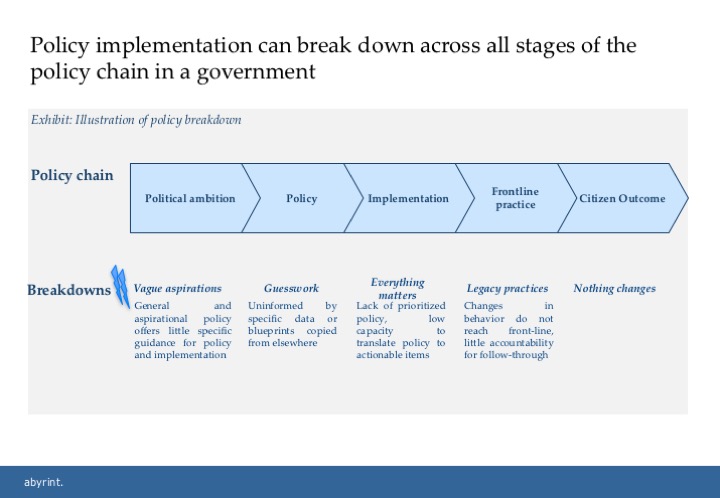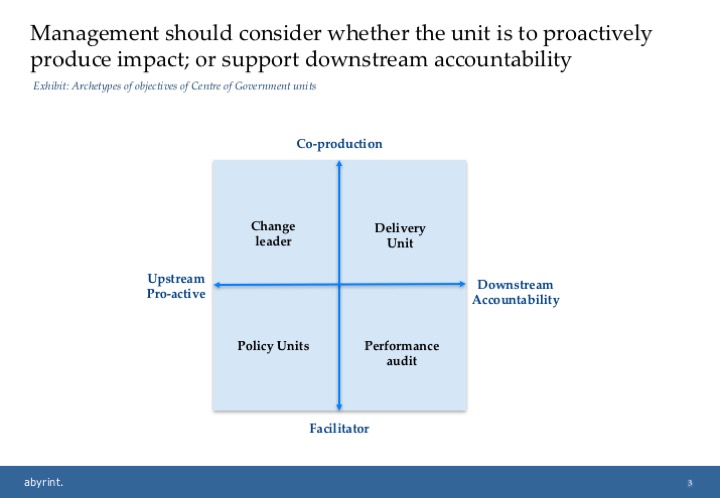Strategic Redesign of Centre of Government (CoG) Delivery Units
Published on: Fri Mar 18 2016 by Ivar Strand
Centre of Government units can be important to coordinate and accelerate change across a government. Such units are trying to address implementation shortcomings by building heavy-hitting capability within key government institutions, typically in offices of the Prime Minister or of the President. The phenomenon has proliferated across the world in developed, developing and fragile states alike. In this discussion, we will provide some ideas for establishing such a unit in order to ensure it is an effective agent of change.
1. But first, what exactly does a Centre of Government unit do?
Centre of Government units can be defined in several ways. In a wider sense, policy units, as well as performance/internal audits, can be considered Centre of Government units. Newer varieties include “delivery” units, such as the delivery unit made famous by Tony Blair’s government in the U.K., as well as dedicated change leadership entities. The latter types of units are typically more detached from the regular structures of governments and are temporary and extra-bureaucratic.
Beyond an overarching loose definition, there is much variety in how Centre of Government units function. These are often times powerful units, frequently contested, and their centrality attracts both likes and dislikes. They are surrounded by considerable opaqueness and ambiguity and, as a consequence, the differences and effectiveness can be difficult to identify.
There are four archetypical Centre of Government unit functions introduced in this paper. The four archetypes represent the breadth of such units in existence, and they also encapsulate different objectives and design principles. The four types we focus on are:
- Policy units: Centre lead entities charged with formulating policies, overarching or specific.
- Change leaders: Charged with turning political aspiration and policy into reality.
- Delivery units: Centre lead efforts to track, and push progress, across government. Often focused on high priority issues.
- Performance audit: Post-implementation review of policy, increasingly also evaluating during implementation to learn and adjust policy for the future. Also performed by Supreme Audit Institutions in several Jurisdictions.
Given this variety, there are some key considerations that must be assessed in establishing such a unit:
2. Determine the objectives of the unit
Centre of Government units are established to compensate for a breakdown in the government policy cycle. During implementation, such breakdowns occur in several areas. The traditional depiction of a policy cycle is largely aspirational, whereby political objectives are transformed into implementable policy programs that are eventually evaluated, ex-post, to inform the formulation of new policies. The cycle is complete. In real life, however, there is a breakdown in capacity and accountability across the policy chain.
Exhibit 1 Illustration of breakdowns in the policy implementation chain

It is important to appreciate the fundamental reason for the policy breakdown when designing the new solution. Dedicated capacities can be established to address shortcomings in the regular government capacity. Different solutions can be effective depending upon the nature of the problem.
Within the same government, capabilities can vary across institutions and according to particular situations. The reasons for policy breakdowns also vary. Especially in developing countries and fragile states, there is likely to be higher institutional volatility.
It is critical to establish clarity on two core questions in order to obtain clear direction for staff and external stakeholders during implementation.
- Will the unit solve ‘downstream’ or ‘upstream’ policy issues? Whether the unit is predominantly to push for accountability and performance measurement, as a “downstream” policy function, or whether it functions as a pro-active advisor, solving “upstream” policy or implementation problems, is an important decision. These are different implementation logics that are difficult to combine. Combinations are possible but will require even more management attention during implementation.
Exhibit 2 Archetypes of Centre of Government units

- Will the unit be a ‘facilitator’ or ‘co-producer’ of change? Whether the unit is deliberately engaging with the implementing agencies to bring about change, or whether it is at arms-length from the implementing agencies and has little responsibility for their success or failure is another key decision.
Exhibit 3 Framework for determining objectives of Centre of Government units

Answering these two questions will get you much closer to understanding which archetypal unit may provide the best starting point, which leads nicely into an analysis of the four types of units.
3. Take inspiration from the four archetypal role models when designing the unit
Policy advisory units: This role is common and predates the “delivery” unit concept. Such units are typically found in the upstream policy cycle. They are involved in policy formulation, sometimes facilitating and other times leading, but are less involved in implementation. These can be “permanent” or temporary structures. Ministries of Planning, and functions of a Finance Ministry typically perform such functions on a permanent basis, but there may also be dedicated policy capacity around a President or Prime Minister, focused on certain high priority issues. An example of a temporary structure is the Policy Unit in the nascent Federal Government of Somalia during 2012 to 2014 that focused on establishing the overarching development policies for the government.
Change leader units: These typically bridge functions between policy and implementation. They may take an active part in strategy and operationalization of policy, be involved in the co-production of a program, and translate aspirations into real life actions. The BRR unit for the Aceh-Nias reconstruction during 2005-2009 in Indonesia may have been such an archetypical unit. It was staffed by specifically recruited Indonesian locals and diaspora, and in the early days, staffed by the global management consulting firm McKinsey. These are typically temporary units, extra-bureaucratic and outside of the normal “line”. Indonesia later established a “delivery” unit as described below.
Delivery units: Familiarized for the world mainly through the U.K government variety. In one key dimension, these units emphasize accountability and downstream implementation aspects. They keep track of targets and measure performance during implementation to ensure that the production units in government deliver. They may be focused on special issues or work government-wide. They may take part in coordination or co-production to ensure implementation, and they are typically environed as temporary and extra-bureaucratic structures.
Delivery units, however, are typically focused around tracking and pushing for performance targets at underlying institutions. This requires a certain basic set of accountability structures to be established. Such accountability structures are likely to be completely collapsed or otherwise deficient in fragile states.
Exhibit 4 Pre-conditins for effective delivery units

Performance/internal audit units: This is the traditional government accountability function. Typically institutionalized within Supreme Audit Institutions, this is also frequently internalized as departments in large institutions. They review achievements with regards to objectives. They differ from delivery units in that their work takes place ex-post and they have little direct influence on implementation. These units are typically permanent and have institutionalized structures, although in conjunction with aid-financed programs there are several ad-hoc arrangements around accountability and performance measurement.
4. Build a fit-for-purpose Centre of Government unit by balancing key characteristics from archetypical role models
A Centre of Government unit may need to balance different role-model characteristics within the same roof. While it may be easier to nurture one role model, in developing and fragile states in particular the situation may require agility to handle different scenarios.
Balancing of mandates and authority may also be important. For example, Presidential involvement carries weight and displacement power and can quickly overwhelm and depower the government institutions responsible for the particular area. Practical ways of resolving such dilemmas include deliberate ways to engage and involve the other government institutions in the work. There is also much potential for overlap and misalignment between Prime Minister’s Offices, Cabinet secretariats and/or Presidents Offices. Also Ministries of Planning and/or Finance may hold overarching mandates that overlap with Centre of Government unit focus.
Exhibit 5 Balancing the authority of Central vs. Ministries

When straddling between different role models, certain features of the situation can guide how to engage with particular issues.
First, by judging the impact of the issue. The impact can be decided by assessing both the importance and the urgency of addressing the problem.
Second, by considering where involvement from the unit can add value. This can be determined by two main factors; (i) The extent to which there is capability in government to manage the issue. If little capability, which is likely in many situations, the unit can be more proactive in managing the situation; and (ii) Degree of alignment of a political or strategic character. At times, involvement may also be motivated by concerns of misalignment.
It is helpful for both internal and external purposes that these principles are shared and understood by all actors involved.
Exhibit 6 Framework for determining roles of Centre of Government units

Having decided upon these strategic considerations, there will inevitably be other critical implementation aspects to consider. When building the institution, it will be especially important to consider:
- How to establish the core production and support systems as these may differ from normal government units; and
- How to acquire and develop talent as the unit may need to recruit on criteria not commonly used by public sector.
Implementation aspects are complicated and warrant dedicated attention beyond what we can cover in this article! These are our experiences and insights and please let us know what your take on this is!
Ivar Strand. Managing Partner @abyrint



